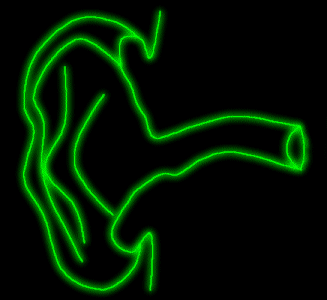The Outer Ear

Pinna:
|
|
The pinna is the visible part of the ear that resides outside of the head. We often use the pinna, also called the auricle, for hanging earrings and resting eyeglasses, but the primary purpose of the pinna is to collect sound. It does so by acting as a funnel, amplifying the sound and directing it to the ear canal. While passing through the pinna, sound also goes through a filtering process in which sounds in the frequency range where human speech is normally found are enhanced. Finally, the filtering process also adds directional information to the sound.
|
Auditory Canal:
| The auditory canal has two main functions: it provides a passageway for sound traveling from the pinna to the eardrum, and it protects the ear from infection. On average, the canal is 3.5 cm long and .7 cm wide. In order to protect the ear, the auditory canal has several lines of defense. The part of the tube closest to the pinna is full of nerve endings and is covered with soft, sensitive skin. Old skin is pushed out when new skin grows, naturally cleaning the ear canal. Further in, the canal contains small hairs that filter out debris. The final line of defense protecting the ear is a group of wax fibers called cerumen strands. These strands are electrostatically charged, allowing them to catch small dust particles. The only thing that is able to successfully pass through the auditory canal is the sound itself, which then continues to the eardrum.
|
Eardrum:
| The eardrum plays a key role in hearing. At about 1 cm in diameter, the eardrum consists of three layers of different materials. The layer closest to the auditory canal is composed of skin; the next layer is of a fibrous and elasic material; the final layer is a mucus producing lining. The annulus, a fibrocartilaginous (made of a special type of cartilage) ring, holds the eardrum in place. The eardrum is very thin and translucent. The eardrum vibrates when impacted by sound waves that have traveled through the auditory canal, and then transfers these vibrations to the middle ear.
|

